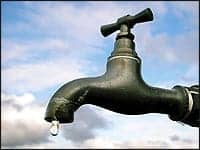 |
Statistics from the US Centers for Disease Control and Prevention (CDC) have indicated that health care-associated infections (HAI) account for an estimated 1.7 million infections and 99,000 deaths annually in American hospitals.1 These infections also add to the expense of caring for these patients, costing hospitals and our health care system billions of dollars per year. As the risks for such infections are disproportionately high in artificially ventilated and critically ill individuals, respiratory care practitioners must remain alert to potential etiologic factors as well as means for reducing such hazards. Emerging evidence demonstrates that hospital tap water is a source for such infections. One investigation has estimated that 1,400 deaths occur each year in the United States as a result of waterborne nosocomial pneumonias attributable to Pseudomonas aeruginosa alone.2 The increasing incidence of serious HAI due to such multidrug-resistant Gram-negative pathogens suggests that greater urgency in efforts to reduce the risk of waterborne transmission of these microbes in the health care environment is warranted.
Caught on Biofilm
Ubiquitous in hospital plumbing, as in nature, waterborne microbes have adapted to life in such hostile environments by forming biofilm. Biofilm is a microbially derived, sessile community, characterized by cells that are irreversibly attached to a substratum or interface or to one other. These cells are embedded in a matrix of extracellular polymeric substances that they have produced and exhibit an altered phenotype with respect to growth rate and gene transcription.3 Among the evident adaptive changes to a nutrient-poor environment is that these microbes become more difficult to identify in nutrient-rich incubation media commonly used for clinical isolates. This may have contributed to a general lack of understanding of the importance of waterborne pathogens in HAI.
Biofilm affords microbial pathogens protection from adverse environmental conditions outside the host4; and it has been established that biofilm bacteria display a higher level of resistance to antimicrobial agents5-9 and environmental controls (eg, ultraviolet light, metals, and acid pH)10-12 than do planktonic (free-floating) bacteria. Of interest, for clinically important organisms such as P. aeruginosa, is that a single genetic locus is associated with both the ability to form biofilm and antimicrobial resistance.13 These biofilms often consist of several species of bacteria.
Some waterborne pathogens of recognized virulence include P. aeruginosa, Stenotrophomonas maltophilia, Acinetobacter species, and Legionella species. In addition, atypical mycobacteria and aspergillus are other potential waterborne pathogens of importance in respiratory infection. Some (eg, Pseudomonas species, Legionella species, and atypical mycobacteria) are also resistant to digestion by free-living waterborne amoebae that upon phagocytosing these bacteria may act as “Trojan horses,” protecting the pathogens from disinfection by chlorination, acid pH, osmotic pressure, and temperature, and transporting them to the faucet or shower where they enter the health care environment.14
In normal hosts, microbial exposures from showers, faucets, and other aqueous sources (eg, by inhalation or ingestion) are typically cleared by innate defenses (eg, mucociliary escalator clearance of inhaled organisms).15 Thus, immunocompromised hosts—recipients of bone marrow and solid organ transplants, individuals with congenital or acquired immunodeficiency syndromes, oncology and burn patients, critically ill adults and children in intensive care units, smokers, individuals with chronic cardiac and respiratory disorders, residents of skilled nursing facilities, and neonates—are likely to be at higher risk. It is precisely for such patients that appropriate environmental infection control methods are most important.
“New” Filtration Technology
Measures often used to control waterborne pathogens in hospital plumbing systems include hot water flushing, chlorination, chlorine dioxide, monochloramine (used exclusively at the municipal treatment level in the United States), copper-silver ionization, and ultraviolet light. Though each method has advantages and disadvantages in terms of ease of implementation, cost, maintenance issues, and short- and long-term effectiveness, none have proven completely effective in the long-term eradication of biofilm. The efficacy of systemic water treatments may be enhanced by using more than one at a time, but this strategy is associated with increased cost.16
Although the implementation of point-of-use (POU) water filtration for at-risk patient populations in the health care setting is relatively new in the United States, this technology has been used extensively in Europe for the past decade. Point-of-use filtration studies have appeared extensively in the scientific literature and have repeatedly addressed the role of filtration technology in both reducing infections due to waterborne pathogens and reducing costs to health care institutions.
In a critical care study spanning 2 years, Trautmann et al17 documented a decrease in the monthly rate of P. aeruginosa infections in a surgical intensive care unit from 2.5 per month prior to POU filter installation, to 0.8 per month after POU filter installation. Van der Mee-Marquet et al18 surveyed pseudomonal infections over 23,611 patient days in the critical care environment over a period of 7.5 years (90 months), demonstrating a decline from 8.7 infections per 1,000 patient days to 3.2 infections per 1,000 patient days following the implementation of POU filtration.
The added cost incurred for HAI in US hospitals has been estimated at $15,275 to $38,656 per infection.19,20 Thus, while studies have supported the use of POU water filters to reduce at-risk patient exposure to waterborne pathogens, economic benefits can also be realized by health care institutions that adopt such technology. With the likelihood that changes in US Centers for Medicare and Medicaid Services (CMS) reimbursement policy will ultimately eliminate reimbursement to health care facilities for costs incurred in treating specific HAI, greater cost savings may be expected by institutions engineering a safer patient care environment by various means, such as implementation of POU filtration technology.
While it has been suggested that hospital water distribution systems are among “the most overlooked, important, and controllable sources of HAI,”2,4,21 the use of tap water for patient care performed outside the hospital, where less attention is typically paid to good infection control practice, is very likely more pervasive than we realize. For example, respiratory therapists should be concerned about the home treatment of obstructive sleep apnea using continuous positive airway pressure (CPAP) with humidifiers. Unlike hospital treatment where sterile water is often used in humidifiers, home care often involves the use of tap water. Recent data suggest that patients who do not adequately clean their humidifiers are at substantially higher risk for respiratory infections, and that filters may provide benefit.22 These data support the view that water may be an underappreciated but significant source of HAI and that POU filtration offers the advantage of immediate effectiveness in reducing this risk.
Joseph S. Cervia, MD, MBA, is clinical professor of medicine and pediatrics, Albert Einstein College of Medicine, and medical director and senior vice president, Biomedical Division, Pall Medical, East Hills, NY; James M. Maguire, PhD, RCP, is senior scientist/lecturer, Pall Life Sciences, and senior consultant, respiratory care, Veterans Administration Regional Medical Center/Dartmouth Alliance,White River, Vt; Francis P. Canonica, PhD, is vice president of Water and Critical Care Filtration Marketing, Life Sciences Hospital Division, Pall Corp; Girolamo A. Ortolano, PhD, is senior vice president for Scientific Affairs & Cell Therapy Field Applications, Pall Corp.
References
- Estimates of Healthcare Associated Infections. Available at: www.cdc.gov/ncidod/dhqp/hai.html. Accessed January 14, 2008.
- Anaissie EJ, Penzak SR, Dignani,MC. The hospital water supply as a source of nosocomial infections: a plea for action. Arch Intern Med. 2002;162:1483-92.
- Donlan RM, Costerton JW. Biofilms: survival mechanisms of clinically relevant microorganisms. Clin Microbiol Rev. 2002;15:167-93.
- Lindsay D, von Holy A. Bacterial biofilms within the clinical setting: what healthcare professionals should know. J Hosp Infect. 2006;64:313-25.
- Costerton JW, Lewandowski Z, Caldwell DE, Korber DR, Lappin-Scott HM. Microbial biofilms. Annu Rev Microbiol. 1995;49:711-45.
- Donlan RM. Biofilms: microbial life on surfaces. Emerg Infect Dis. 2002;8:881-90.
- Lindsay D, von Holy A. Different responses of planktonic and attached Bacillus subtilis and Pseudomonas fluorescens to sanitizer treatment. J Food Prot. 1999;62:368-79.
- Dodds MG, Grobe KJ, Stewart PS. Modeling biofilm antimicrobial resistance. Biotechnol Bioeng. 2000;68:456-65.
- Meyer B. Approaches to prevention, removal and killing of biofilms. Int Biodeterior Biodegradation. 2003;51:249-53
- Hall-Stoodley L, Costerton JW, Stoodley P. Bacterial biofilms: from the natural environment to infectious diseases. Nat Rev Microbiol. 2004;2:95-108.
- Hall-Stoodley L, Stoodley P. Biofilm formation and dispersal and the transmission of human pathogens. Trends Microbiol. 2005;13:7-10.
- Jefferson KK. What drives bacteria to produce a biofilm? FEMS Microbiol Lett. 2004;236:163-73.
- Drenkard E, Ausubel FM. Pseudomonas biofilm formation and antimicrobial resistance are linked to phenotypic variation. Nature. 2002;416:740-43.
- Greub G, Raoult D. Microorganisms resistant to free-living amoebae. Clin Microbiol Rev. 2004;17:413-33.
- Prince A. Biofilms, antimicrobial resistance, and airway infection. N Engl J Med. 2002;347:1110-1.
- Cervia JS, Ortolano J, Canonica G. Hospital tap water: a reservoir of risk for healthcare-associated infection. Infect Dis Clin Prac. 2008. In press.
- Trautmann M, Royer H, Helm E, May W, Haller M. Pseudomonas aeruginosa: new insights into transmission pathways between hospital water and patients. Filtration. 2004;1(Supplement 1):63-70.
- Van der Mee-Marquet N, et al. Water microfiltration: a procedure to prevent Pseudomonas aeruginosa infection. XVI Congrès Nat. Soc. Franc. D’Hyg. Hospitaliere, Water and Hospital Symposium. 2005; Reims, France. Abstract S.137. (Only ref I found to this was the power point side)
- Roberts RR, Scott RD II, Cordell R, et al. The use of economic modeling to determine the hospital costs associated with nosocomial infections. Clin Infect Dis. 2003;361:424-32.
- Zhan C, Miller MR. Excess length of stay, charges, and mortality attributable to medical injuries during hospitalization. JAMA. 2003;290:1868-74.
- Ortolano GA, McAlister MB, Angelbeck JA, et al. Hospital water point-of-use filtration: a complementary strategy to reduce the risk of nosocomial infection. Am J Infect Control. 2005;33(5 Suppl 1):S1-19.
- Ortolano GA, Schaffer J, McAlister MB, et al. Filters reduce the risk of bacterial transmission from contaminated heated humidifiers used with CPAP for obstructive sleep apnea. J Clin Sleep Med. 2007;3:700-5.









